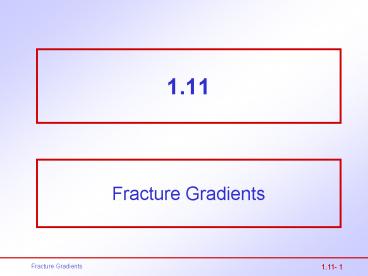Petroleum Engineering 405 Drilling Engineering - PowerPoint PPT Presentation
1 / 36
Title:
Petroleum Engineering 405 Drilling Engineering
Description:
Safe drilling practices require that the following be considered when planning a ... Mathews & Kelly: 0.917 17.63. Ben Eaton: 0.927 17.82. Fracture Gradients. 1.11- 28 ... – PowerPoint PPT presentation
Number of Views:332
Avg rating:3.0/5.0
Title: Petroleum Engineering 405 Drilling Engineering
1
1.11
Fracture Gradients
2
Prediction of Fracture Gradients
- Well Planning
- Theoretical Fracture Gradient Determination
- Hubbert Willis
- Matthews Kelly
- Ben Eaton
- Comparison of Results
- Experimental Frac. Grad. Determination
- Leak-off Tests
3
Well Planning
- Safe drilling practices require that the
following be considered when planning a well - Pore pressure determination
- Fracture gradient determination
- Casing setting depth selection
- Casing design
4
Formation Pressure and Matrix Stress
- Given Well depth is 14,000 ft.
Formation pore pressure expressed in
equivalent mud weight is 9.2 lb/gal.
Overburden stress is 1.00 psi/ft.
Calculate 1. Pore pressure, psi/ft , at
14,000 ft 2. Pore pressure, psi, at 14,000
ft 3. Matrix stress, psi/ft 4. Matrix
stress, psi
5
Formation Pressure and Matrix Stress
S P s
overburden pore
matrix stress pressure
stress (psi)
(psi) (psi)
6
Formation Pressure and Matrix Stress
Depth 14,000 ft. Pore Pressure 9.2
lb/gal equivalent Overburden stress 1.00
psi/ft.
- Calculations
- 1. Pore pressure gradient
- 0.433 psi/ft 9.2/8.33 0.052 9.2
- 0.478 psi/ft
- 2. Pore pressure at 14,000 ft
- 0.478 psi/ft 14,000 ft
- 6,692 psig
7
Formation Pressure and Matrix Stress
- Calculations
- 3. Matrix stress gradient,
psi psi/ft
s / D 0.522 psi/ft
8
Formation Pressure and Matrix Stress
- Calculations
- 4. Matrix stress at 14,000 ft
- 0.522 psi/ft 14,000 ft
- s 7,308 psi
9
Fracture Gradient Determination
- In order to avoid lost circulation while drilling
it is important to know the variation of fracture
gradient with depth. - Leak-off tests represent an experimental approach
to fracture gradient determination. Below are
listed and discussed three approaches to
calculating the fracture gradient.
10
Fracture Gradient Determination
- 1. Hubbert Willis
- where F fracture gradient, psi/ft
- pore pressure gradient, psi/ft
11
Fracture Gradient Determination
- 2. Matthews Kelly
- where Ki matrix stress coefficient
- s vertical matrix stress,
psi
12
Fracture Gradient Determination
- 3. Ben Eaton
- where S overburden stress, psi
- g Poissons ratio
13
Example
- A Texas Gulf Coast well has a pore pressure
gradient of 0.735 psi/ft. Well depth 11,000
ft. - Calculate the fracture gradient in units of
lb/gal using each of the above three methods. - Summarize the results in tabular form, showing
answers, in units of lb/gal and also in psi/ft.
14
Example - Hubbert and Willis
- 1. Hubbert Willis
- The pore pressure gradient,
15
Example - Hubbert and Willis
- Also,
16
Example - Hubbert and Willis
0.8675 psi/ft Fmax 16.68 lb/gal
17
Example
- 2. Matthews Kelly
- In this case P and D are known, may be
calculated, and is determined graphically. - (i) First, determine the pore pressure gradient.
18
Example - Matthews and Kelly
- (ii) Next, calculate the matrix stress.
S P s
s S - P 1.00 D - 0.735 D 0.265
D 0.265 11,000 s 2,915 psi
19
Example - Matthews and Kelly
- (iii) Now determine the depth, , where, under
normally pressured conditions, the rock matrix
stress, s would be 2,915 psi.
Sn Pn sn
n normal 1.00 Di 0.465 Di 2,915
Di (1 - 0.465) 2,915
20
Example - Matthews and Kelly
- (iv) Find Ki from the plot on the right, for
- For a south Texas Gulf Coast well,
Di 5,449 ft
Ki 0.685
21
Example - Matthews and Kelly
- (v) Now calculate F
22
5,449
Depth, Di
0.685
Ki
23
Example
- Ben Eaton
24
Variable Overburden Stress by Eaton
- At 11,000 ft
- S/D 0.96 psi/ft
25
Fig. 5-5
- At 11,000 ft
- g 0.46
26
Example - Ben Eaton
- From above graphs,
- at 11,000 ft.
F 0.9267 psi/ft 17.82 lb/gal
27
Summary of Results
- Fracture Gradient
- psi.ft lb/gal
- Hubbert Willis minimum 0.823 15.83
- Hubbert Willis maximum 0.868 16.68
- Mathews Kelly 0.917
17.63 - Ben Eaton 0.927
17.82
28
Summary of Results
- Note that all the methods take into
consideration the pore pressure gradient.
As the pore pressure increases, so does the
fracture gradient. - In the above equations, Hubbert Willis
apparently consider only the variation in
pore pressure gradient. Matthews Kelly
also consider the changes in rock matrix stress
coefficient, and in the matrix stress ( Ki
and si ).
29
Summary of Results
- Ben Eaton considers
- variation in pore pressure gradient,
overburden stress and - Poissons ratio,
- and is probably the most accurate of the three
methods. The last two methods are actually
quite similar, and usually yield similar results.
30
Similarities
- Ben Eaton
Matthews and Kelly
31
(No Transcript)
32
Experimental Determination of Fracture Gradient
- The leak-off test
- Run and cement casing
- Drill out 10 ft below the casing seat
- Close the BOPs
- Pump slowly and monitor the pressure
33
(No Transcript)
34
(No Transcript)
35
(No Transcript)
36
(No Transcript)































